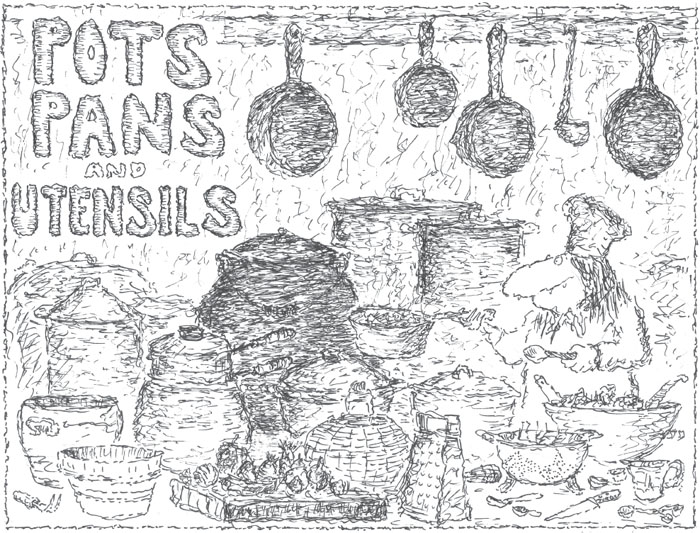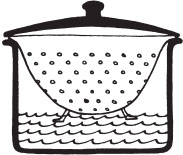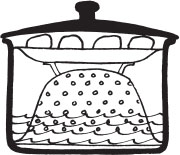
I have no special kitchen for catering, and few special pots. The following hints give some ideas as to accommodations anyone might make for a large dinner.
First, obtain a large preserving kettle, usually quite inexpensive. I use two, and they are suitable for many tasks: marinating meats, simmering chickens, mixing large quantities of dough or batter. If you are not going to invest in good, large catering pans, use heavy-duty foil roasting pans and foil pie tins. But for stews and other slow-cooking dishes, it is important to have a heavy pot.
If you plan much large-scale cooking, you should buy the largest porcelainized cast-iron Dutch oven you can afford. The Belgian and French are the best. Also, at junk shops and at some hardware stores you can find heavy cast-iron kettles, of the sort that used to hang in fireplaces. These need to be seasoned and carefully wiped after every use, but they cook evenly and well.
A large wooden tabletop is needed for chopping and slicing; small breadboards are not enough. If you haven’t a top you can cut on, get a large, table-sized piece of hardwood to lay over your table.
One of the best places on which to work is the floor: if it is clean, it is a wonderful, flexible space. Cover it with a large sheet of vinyl first. When I was in Nepal, my friends’ cook worked on the floor, and it was much more convenient than juggling pots and pans and mounds of vegetables on small counter spaces. We had large round panniers on which the foods were spread, wooden slabs to cut on, and huge stone mortars for grinding and pounding. It was a liberating experience.
In the salad recipe on page 126 I describe my use of the floor (and bed sheets) for drying fifty people’s worth of greens. Have a child or two help.
There are some special devices that should be described more fully. In the preparation of many Middle Eastern and Chinese dishes a steamer is needed. If, as is likely, you haven’t a large one, you may improvise one as follows: Place a metal colander or very large sieve over a kettle one-third full of water in such a way that it is suspended over the water—you may have to tie it to the handles of the pot. For couscous or other fine ingredients to be steamed, line the colander with double cheesecloth first.

When you steam dumplings, like momos, place them on a greased plate in the steamer or colander, or construct the following:
